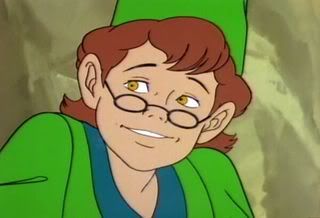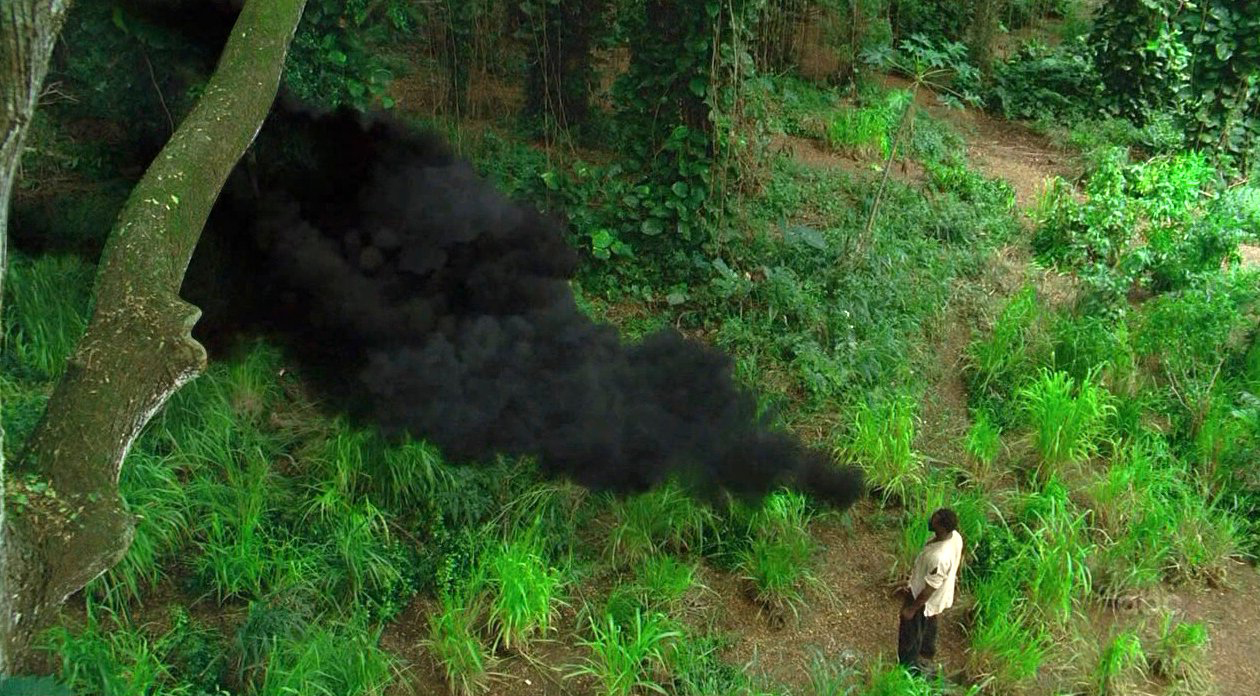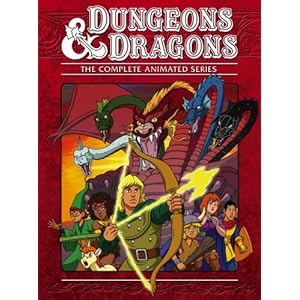Cartoons in the ‘80s
were a bit of a mixed bag. The cynics
will tell you that ‘80s cartoons were just elaborate advertisements created to
sell action figures and other merchandise—commercials with commercials. But while marketing toy lines was certainly a
consideration, the idea that ‘80s cartoons had no substance is false. Many—nay, MOST—of the cartoons from the 1980s
were enjoyable to the kids who grew up on them—and a number of them are still
great to watch today.
For this entry,
we’re going way back to the mid-1980’s—really the dawn of “The Golden Age For
Kids”—to remember a cartoon that helped pave the way for a lot of the best
cartoons and kids shows of the next 15 years.
I didn’t watch Dungeons & Dragons in its original run, as I was only
a small child when it first aired, and I’ve never played the role-playing game
either. But after hearing some good
things about the show and realizing that the entire 27 episode series was available on Amazon for less than $10, I thought I’d give it a shot.
And I’m very
glad I did.
Overview
On a trip to an
amusement park, a group of 6 kids (5 teens, 1 pre-teen) decide to check out a
Dungeons & Dragons ride. However,
something goes wrong on the ride and they are unexpectedly transported to a
strange and mysterious realm—the realm of Dungeons & Dragons. There they meet fierce opponents, including
the evil sorcerer Venger and the 5-headed dragon Tiamat. Their guide to the realm is the wise and
powerful but enigmatic Dungeon Master, who grants each of the six kids a role
and a power: Ranger, Barbarian, Thief, Magician, Cavalier and Acrobat. The kids use their powers/weapons to defend
themselves and fight against evil as they move through the realm trying to find
a way back home.
Principle Characters
Hank
 |
| dungeonsdragonscartoon.com |
The
blonde-haired, blue-eyed Hank is the group’s natural-born leader. It’s never specified, but Hank is your
standard “captain of the football team” type.
He’s decisive, level-headed, principled and courageous. Dungeon Master makes Hank the Ranger, meaning
he has a longbow that shoots energy arrows.
There is no central protagonist in D&D, but Hank is probably the
closest thing. I imagine that young boys
watching the show would look up to Hank the most. Hank is voiced by Willie Aames who many
Golden Agers may remember as Buddy Lembeck from Charles in Charge.
Sheila
 |
| nightmarefuelpodcast.blogspot.com |
Blue-eyed, red-haired
and freckled, Sheila is the group’s most emotional member and at times provides
a mother-like presence. Dungeon Master proclaims
her to be the Thief—which apparently does not carry a negative connotation in
the realm of D&D. Her “weapon” is a
cloak that makes her invisible when she puts on its hood. While it’s probably not the coolest weapon of
the bunch, it helps the gang escape from a number of difficult situations. Many hints are given that Sheila’s feelings
for Hank may go beyond just friendship, but nothing is ever confirmed.
 |
| More than Friends? via thatguywithglasses.com |
Bobby
 |
| absoluteanime.com |
The group’s
youngest member by several years, the impetuous Bobby is Sheila’s younger
brother. Playing the role of Barbarian,
Bobby wields an oversized club that shakes the earth when he slams it
down. Like his sister, Bobby is an
emotional character, a little bit temperamental and very protective—especially
of Uni, the group’s unicorn mascot.
Presto
 |
| via DeviantArt |
A bumbling
amateur magician known for botching card tricks in the earth realm, Presto’s
role in the realm of D&D isn’t all that unfamiliar as Dungeon Master
conveniently decides that he will be a magician. Unfortunately for Presto, his difficulties
performing magic tricks persist in the new realm too. This leads to Presto lacking in
self-confidence. His hat has magical
powers, enabling him to cast spells and pull key items from it to help the crew
in times of peril. The only problem is
that Presto rarely gets it right and more often ends up pulling something
ridiculous from his hat, providing a little levity. Once in a while though, Presto comes through
and saves the gang with his magic.
 |
| darkhorde.blogspot.com |
Diana
The tough but
friendly Diana is given the title of Acrobat, which works well since in the
earth realm she was an all-state gymnast.
Her weapon is a magical staff, which she often uses in more of a pole
vault fashion. Diana is amicable, courageous,
and very independent. Other than Hank,
she seems to be the group’s strongest leader.
Overall, Diana is a good role model for female D&D fans and is
probably the character who would be most fun to hang out with in real life.
Eric
 |
| kazimskorner.blogspot.com |
The
ultra-sarcastic Eric fills the “wise-cracking sidekick” role for the group. A spoiled child of wealthy parents in the earth
realm, Eric is prone to whining about the group’s situation. He’s also famous for acting tough but
cowering when facing a dragon, monster, or other enemy. Though his friends tend to view him as a
complainer and a general pain in the butt, Eric’s cynicism is very accurate at
times and his frequent questioning of Hank’s leadership provides the group with
an important voice of dissent. He also
brings some comic relief—many times the whole group will get a good laugh out
of watching Eric freak out about some harmless creature chasing him. Dungeon Master makes Eric the Cavalier,
meaning he has a protective shield.
Despite acting cowardly at times, Eric steps up and uses his shield
admirably to defend the group from attackers on more than one occasion. Eric is voiced by Don Most, famous for his
role as Ralph Malph on Happy Days.
Dungeon Master
 The mysterious
Dungeon Master presents himself to the kids as their guide to the realm of
Dungeons and Dragons. Appearing as a
very small and bald old man, Dungeon Master is also a supremely powerful wizard
and is very knowledgeable about the realm.
He tends to communicate in riddle form, often befuddling the
children. There is a certain Yoda-like
quality to Dungeon Master, but at times it seems like he is deliberately
withholding information from the kids, and his true motives are hidden. Dungeon Master seems to have an interesting
relationship with Venger, the realm’s most dangerous sorcerer and most feared
villain, but details are scarce.
The mysterious
Dungeon Master presents himself to the kids as their guide to the realm of
Dungeons and Dragons. Appearing as a
very small and bald old man, Dungeon Master is also a supremely powerful wizard
and is very knowledgeable about the realm.
He tends to communicate in riddle form, often befuddling the
children. There is a certain Yoda-like
quality to Dungeon Master, but at times it seems like he is deliberately
withholding information from the kids, and his true motives are hidden. Dungeon Master seems to have an interesting
relationship with Venger, the realm’s most dangerous sorcerer and most feared
villain, but details are scarce.
Venger
 |
| dungeonsdragonscartoon.com |
If Dungeon
Master is the realm’s Yoda, Venger is its Darth Vader. An evil Sorcer, Venger is known for his
fangs, his bat-like wings, and his iconic one-horned helmet. He rides a black stallion that can fly
through the sky. In addition to his own
powerful magic abilities, Venger is in control of an army of orcs and has a
shadow demon as his right hand man. The
only force in the realm more powerful than Venger is the dragon Tiamat. Venger seeks the 6 weapons that the protagonists
possess, for if he can obtain them he will be strong enough to defeat Tiamat
and control the realm. Venger is voiced
by Peter Cullen, most famous for voicing Optimus Prime throughout the
Transformers series and Eeyore in Winnie the Pooh.
Episode
Structure
Episodes of
D&D:TAS tend to follow a pretty standard pattern. The group will be meandering aimlessly or working
toward some forgettable task when Dungeon Master will mysteriously appear from
nowhere. He’ll provide them with a
cryptic clue of how they might get home, often using puns and riddles rather
than simply telling the kids what to expect.
Then, just as quickly as he arrived, Dungeon Master seemingly vanishes,
and the heroes are left to try to decipher his directions.
 |
| via thetrades.com |
They’ll set out
in whatever direction Dungeon Master told them, but on the way they will run
into some other person or group who is either imprisoned in the realm or
somehow being victimized by a monster or a spell. The heroes will nobly put the interest of
this person/group ahead of their own and free them from their captors. Somewhere along the way Venger gets involved
but he is fended off. It’s a happy
ending for the victims, but Hank, Sheila, Bobby, Presto, Diana and Eric are
still stuck in the realm without much direction. Dungeon Master tends to show up again near
the end, and it will become clear that helping the helpless and/or freeing the
oppressed was his ulterior motive all along.
Most episodes end on a light note, often times with Eric getting himself
into a sticky situation to the amusement of the others.
Miscellaneous
Thoughts & Analysis
It took a few
episodes for me to fully latch on to D&D.
It started a bit slow, but once you got a little more familiar with the
characters it was really an engaging cartoon.
By the time I got to the last episodes, I was really sad to see it end.
There are a lot
of “surface” things to like about D&D.
It’s set in a colorful realm that provides all of the necessary
ingredients for a good story. The main
characters are fairly well-written and generally likeable in their own way. Also, many of the characters that the heroes
encounter in their travels have compelling backstories.
 |
| Venger's Castle, via dungeonsdragonscartoon.com |
But probably
what stands out most about D&D was that it had a little bit more depth than
its predecessors. In the ‘70s most of
the cartoon offerings on television were pretty sanitized, like Super Friends,
Scooby-Doo, or Yogi Bear. D&D was
one of the first cartoons to really step outside of that space and show that
kids could handle action and slightly more mature plots, and that animation was
an acceptable way to deliver that content.
The show was not without controversy though—the National Coalition on
Television Violence demanded that the FTC run a warning before each episode and
claimed that it had been linked to real life violence and deaths.
D&D treated
its viewers like they were capable of handling more than the same old formulaic
kid stuff. One of the ways that that was
manifest was by having storylines that wove through multiple episodes. For instance there are many allusions
throughout the show that there is more to the relationship between Dungeon
Master and Venger than what meets the eye.
This subtext persists for a while, until the final moments of the
episode “The Treasure of Tardos” when DungeonMaster says sotto voce (at a time
when no one except the viewer can hear him): “There was good in Venger once—a
long time ago. Everyone makes
mistakes—Venger was mine.” The true
nature of their relationship isn’t revealed until the series’ (unaired) final
episode.
 |
The true nature of Dungeon Master & Venger's relationship
is clouded. via thatguywithglasses.com |
The show also
delivered some more mature themes at times.
Maybe the most popular episode among the show’s fans is Season 2’s “The
Dragon’s Graveyard”. For the first time
the heroes voice their frustration with Dungeon Master for using them to fix up
other problems in the realm. They end up
in the home of Tiamat—the mysterious “Dragon’s Graveyard”—and Hank is faced
with a decision of whether he should kill Venger if it helps the gang get home. One of the show’s writers, Michael Reaves,
suggested that that episode and scene “caused a battle royale with Broadcast
Standards and Practices.”
 |
Jossef Muller, the Nazi who finds redemption
in the realm of Dungeons & Dragons |
Another great
episode that was far more mature than you’d expect was Season 3’s “The Time
Lost”. In this episode Venger uses his
“Crystal of Chronos” to warp space and time, and he pulls both a futuristic
fighter jet and World War II Luftwaffe plane into the realm of Dungeons &
Dragons. Venger’s goal is to send the
Nazi pilot—a man named Josef Muller-- back to the earth realm to win World War
II for Germany, thereby altering Earth’s timeline and preventing the kids from
ever entering the realm of D&D. But
after meeting the heroes, the Nazi pilot has his eyes opened and eventually
finds redemption. This particular
storyline was so mature that I almost couldn’t believe what I was seeing when I
watched it. It’s not every day that you
see a Nazi as a central character in an 80’s kids cartoon.
D&D:TAS
actually has a lot of similarities to one of my favorite post-Golden Age tv
shows: LOST. In both shows, a group of unwilling
passengers crash land in a strange and mysterious place, and the plot of the
show revolves around their quest to find a way back home. In both shows the protagonists encounter a
number of different inhabitants of this strange new place—some good, some bad,
and some who have elements of both. In
both shows the person or entity that is portrayed as being the source of all
evil (or “big” bad guy) turns out to not be, and both shows force you to
question whether the person/entity portrayed as the defender of all that is
good and righteous is really so righteous himself. Heck, both shows even feature nameless
pillars of smoke that have existed for thousands of years and that embody true
evil. The similarities are so numerous
that it makes me wonder whether or not the creators of LOST watched and were
influenced by D&D:TAS.
 |
| Dungeons & Dragons' "The Nameless One" |
 |
| Lost's "Smoke Monster" |
 |
This giant statue inside Venger's castle appears to show Venger
with a 2-horned helmet. Or, perhaps this statue is not OF Venger
but instead someone he idolized. Since we only see the statue from
behind, we'll never know.
|
 |
| A giant statue seen only from behind? Hmmmmmmm. |
Perhaps the
coolest D&D plot is one that never really happened. The show’s final aired episode, The Winds of
Darkness, was good but did not bring the plot to a satisfying conclusion. One more episode, known as Requiem, was written
but never aired. Over the years there
was much discussion about the plot of Requiem, particularly among diehard fans
who used the internet forums to communicate.
One of the most popular theories was that Requiem revealed that the kids
had actually died on the amusement park ride, and that they weren’t truly in a
different realm but in Hell, tortured by Satan in the form of the Dungeon
Master. It’s one of those endings, kind
of like “The Sixth Sense”, that just makes you say “Whoaaaaaa”, because it
would make so much sense if that really WAS what happened. Also, reminds me of more than a few “LOST
theories” I read through the years.

Of course, it is
just an urban legend, as confirmed by Michael Reaves on his personal
website. To clear things up, Reaves went
so far as posting a PDF version of Requiem’s script. While it doesn’t truly wrap up the plot and
it’s not quite as shocking as the Hell reveal would have been, it’s still a
pretty neat episode in its own right.
Some creative folks in the youtube community did a dramatic reading ofthe script, complete with voices that sounded pretty similar to the real
characters. If you watched the show but
haven’t seen the video, it’s definitely worth checking out.
Final Thoughts
Maybe
in some cases there is some merit to the idea that ‘80s cartoons didn’t have a
ton of substance. But Dungeons &
Dragons, to me isn’t one of those cases.
It has its plot holes and a few other issues at times, but overall it’s
a pretty good story that was well ahead of its time in a lot of ways. IGN, which ranked it the 64th best animated
show of all-time, described it as “truly a mature soap opera with swords and
monsters.” I think that’s pretty
fair. The show did a lot of things that
were previously off-limits for kids cartoons and was influential in shaping
what cartoons would look like in the later years of the Golden Age. For that we owe it a debt of gratitude—and
for less than $10, a watch or re-watch.
Special thanks to DungeonsDragonsCartoon.com, an awesome resource for fans of the show.


































